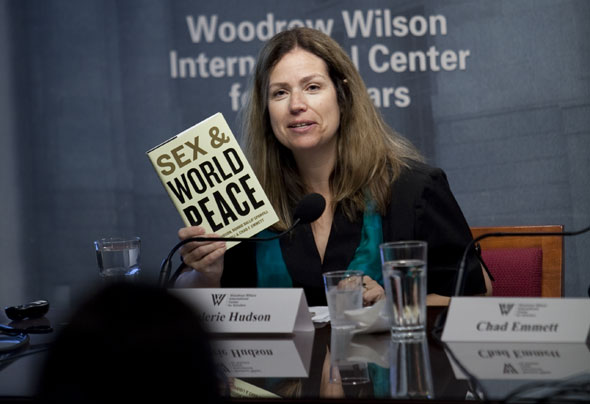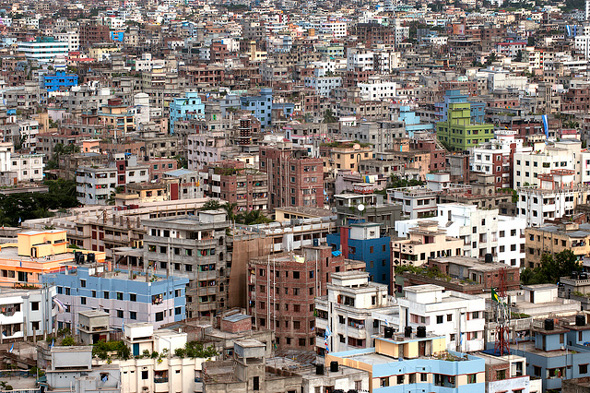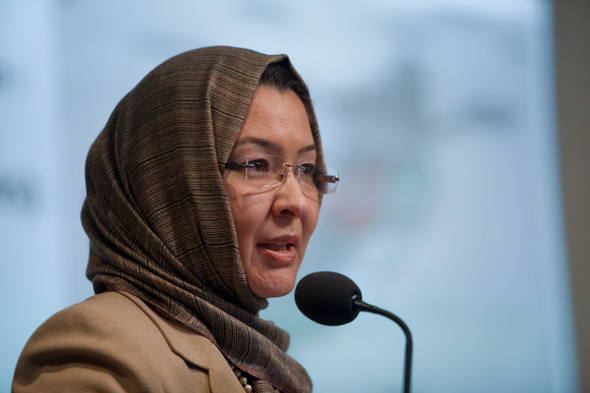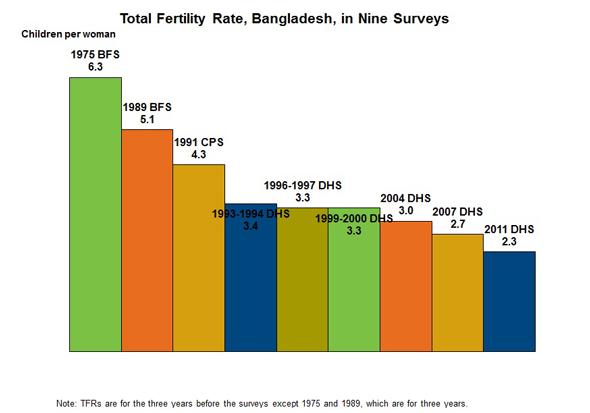-
“Afghanistan, Against the Odds: A Demographic Surprise” Launches ECSP Report 14
›A few months ago, Elizabeth Leahy Madsen broke down Afghanistan’s first-ever nationally representative survey of demographic and health issues in a two-part series here on the blog. Now, we’ve published her analysis in a rich new policy brief format. It is the first issue of Environmental Change and Security Program Report 14, the latest volume of ECSP’s flagship publication.
In “Afghanistan, Against the Odds,” Madsen examines the surprising results of this fall’s demographic survey and how the country’s statistics compare to neighboring Pakistan.
“Just as Afghanistan and Pakistan’s political circumstances have become more entwined,” writes Madsen, “their demographic paths are more closely parallel than we might have expected. For Afghanistan, given its myriad socioeconomic, political, cultural, and geographic challenges, this is good news. But for Pakistan, where efforts to meet family planning needs have fallen short of capacity, it is not.”
The publication of this brief marks the re-launch of ECSP Report as an online-only volume, with individual issues scheduled to be released throughout the year. Forthcoming ECSP Report 14 briefs will address the demographic roots of the Arab Spring; the links between population dynamics and environmental resources like water, biodiversity, and food; and the potential impact of climate change mitigation efforts on conflict.
Published since 1996 in hard copy and online, the new ECSP Report will now be available on the Wilson Center website, New Security Beat, and Issuu. You can read the previous 13 volumes of the ECSP Report on the Wilson Center website.
Download ECSP Report 14: “Afghanistan, Against the Odds” from the Wilson Center. -
Sex and World Peace: How the Treatment of Women Affects Development and Security
›
“What we have discovered is that the very best predictor of how insecure and unstable a nation is not its level of democracy, it’s not its level of wealth, it’s not what ‘Huntington civilization’ it belongs to, but is in fact best predicted by the level of violence against women in the society,” said Valerie Hudson, co-author of Sex and World Peace, at an April 26 book launch at the Wilson Center. [Video Below]
-
Nigeria Beyond the Headlines: Demography and Health [Part One]
›
“Nigeria is a country of marginalized people. Every group you talk to, from the Ijaws to the Hausas, will tell you they are marginalized,” said Peter Lewis, director of the African Studies Program at the Johns Hopkins University School of Advanced International Studies. Lewis spoke at an April 25 conference on Nigeria, co-hosted by ECSP and the Wilson Center’s Africa Program, assessing the country’s opportunities for development given its demographic, governance, natural resource, health, and security challenges. [Video Below]
-
Roger-Mark De Souza, Climate and Development Knowledge Network
Population-Climate Dynamics: From Planet Under Pressure to Rio
›May 11, 2012 // By Wilson Center StaffThe original version of this article, by Roger-Mark De Souza, appeared on the Climate and Development Knowledge Network (CDKN).
In late May, I presented research on population and climate dynamics in hotspots at the Planet Under Pressure conference in London, in a session organized by the Climate and Development Knowledge Network. As we prepare for the Rio+20 Earth Summit in June, I reflect on the roles of population dynamics and climate-compatible development for ensuring a future where we can increase the resilience of the most vulnerable to the impacts of climate change.- Improving our well-being and the future we can have is within our reach: We can take action to improve well-being through specific actions that can produce short term results. This is a key message encapsulated in the concept of climate-compatible development, reflected in many presentations and discussions that I heard at Planet Under Pressure. Even though others were not calling it “climate-compatible development,” the essence and the meaning behind the research was the same – small concrete discrete steps are possible, and taking action on population dynamics is one of them.
- Population is on the agenda: Population issues – growth, density, distribution, aging, gender – were a constant at Planet Under Pressure – and in more ways than just looking at population as a driver. It is clear that there is interest, and a need, to address population as a key component of climate-compatible development.
- But those concerns and issues must be location specific, and must be contextualized for the policy and programmatic environment: Population issues must be framed in the appropriate context – and must move beyond academic exploration. I attended one session where a paper presented an academic supposition of whether we should invest in consumption versus fertility reduction to produce short-term returns for climate, but the analysis was completely devoid of any political, policy, or programmatic truth-testing. We must factor in those considerations when making recommendations, if ultimately we are really looking to make the difference that we can.
Photo Credit: “Urbanization in Asia,” courtesy of United Nations Photo. -
Learning From Success: Ministers of Health Discuss Accelerating Progress in Maternal Survival
›“The gains we have made [in reducing maternal mortality rates] are remarkable; however, gains are fragile and donor resources are declining. Substantial investments must be maintained to safeguard these hard-wins,” said Afghan Minister of Health Suraya Dail at the Wilson Center on April 23. [Video Below]
As part of the Wilson Center’s Global Health Initiative, the Advancing Dialogue to Improve Maternal Health series partnered with the U.S. Agency for International Development to co-host Minister Dail, along with Honorable Dr. Mam Bunheng, Minister of Health, Cambodia; Honorable Dr. Bautista Rojas Gómez, Minister of Health, Dominican Republic; and Dr. Fidele Ngabo, Director of Maternal and Child Health, Ministry of Health, Rwanda.
These ministers spoke about the lessons learned in countries where there has been tremendous progress under challenging circumstances.
In the Dominican Republic, Bautista Rojas Gomez said the first challenge was to address the “Dominican paradox,” where maternal mortality rates were high despite the fact that 97 percent of women received prenatal care and delivered in hospitals. The government created a zero tolerance policy that included a comprehensive surveillance system, mandatory maternal death audits, and community oversight of services, which assured better quality services.
Similar political commitment improved indicators in Cambodia, where maternal mortality rates dropped from 472 to 206 per year from 2005 to 2010. “It takes a village…and the prime minister has inspired the country to act,” said Mam Bunheng. Through increased access to contraception the number of children per woman went from seven to three and commitment to family planning, education, technology, infrastructure, and community have been the key drivers of success.
“In Rwanda, the big challenge we are having is education,” said Fidele Ngabo. “Many of the maternal health indicators depend on education.” When women and girls are educated they are twice as likely to utilize modern contraception. The efforts of Rwanda’s government have been instrumental in facilitating positive change, he said, particularly the efforts of First Lady Jeannette Kagame, who he called a “champion” for women and girl’s health.
As witnessed throughout the Advancing Dialogue to Improve Maternal Health series – and reiterated by the ministers of health – the interventions to improve maternal mortality rates exist, what’s left is to generate the needed political willpower.
Event Resources
Photo Credit: David Hawxhurst/Wilson Center. -
Carl Haub, Behind the Numbers
Bangladesh 2011 Demographic and Health Survey Shows Continued Fertility Decline, Improved Health Indicators
›May 7, 2012 // By Wilson Center StaffThe original version of this article, by Carl Haub, appeared on the Population Reference Bureau’s Behind the Numbers blog.
The Bangladesh 2011 Demographic and Health Survey is the ninth demographic survey taken in the country since 1975. Except for a few very small countries and city-states, Bangladesh is the world’s most densely populated country with about 1,100 people per sq. kilometer. The country’s area is about the same as the U.S. state of Arkansas and a bit more than Greece but is home to over 150 million people.
The preliminary 2011 report has just been released and it shows that fertility has continued its decline to a low level. The total fertility rate (TFR) for the three-year period before the survey was 2.3 – 2.0 in urban areas and 2.5 in rural areas. The survey interviewed 17,842 ever-married women ages 12 to 49 and 3,997 ever-married men ages 15 to 54 from July to December 2011. Rural women accounted for two-thirds of those interviewed. From 1975 to 1994, the TFR in Bangladesh was in continuous decline. But the next three surveys showed a tendency for TFR decline to “stall” at a medium level (see graph). Desired family size has greatly decreased. In the survey, 76.2 percent of women with two living children said that they did not wish to have any more children, an additional 5.3 percent had been sterilized, and 1.3 percent said they were incapable of conceiving.
In the survey, 61.2 percent of currently married women said that they were using some form of family planning, a level comparable to developed countries. The use of modern methods was quite high at 52.1 percent. Unlike neighboring India, where female sterilization predominates, the contraceptive pill is the most widely used modern method at 27.2 percent, followed by injectables (11.2 percent), and the male condom (5.5 percent). Contraceptive use has risen steadily in surveys, up from 7.7 percent in 1975. Family planning use has risen despite the fact that fewer women report a visit from a family planning worker, either government or private. Overall, only 15.5 percent reported contact with a home visitor, which has been an important part of the country’s family planning program. The report notes that this may be due to workers deciding to provide services from community clinics for three days a week.
Continue reading on Behind the Numbers.
Sources: MEASURE DHS.
Imaged Credit: Carl Haub/Behind the Numbers. -
Nicholas Eberstadt, Wilson Quarterly
Population Changes Set to Remake Japanese Society
›The original version of this article, by Nicholas Eberstadt, appeared in the Wilson Quarterly.
In 2006, Japan reached a demographic and social turning point. According to Tokyo’s official statistics, deaths that year very slightly outnumbered births. Nothing like this had been recorded since 1945, the year of Japan’s catastrophic defeat in World War II. But 2006 was not a curious perturbation. Rather, it was the harbinger of a new national norm.
Japan is now a “net mortality society.” Death rates today are routinely higher than birthrates, and the imbalance is growing. The nation is set to commence a prolonged period of depopulation. Within just a few decades, the number of people living in Japan will likely decline 20 percent. The Germans, who saw their numbers drop by an estimated 700,000 in just the years from 2002 to 2009, have a term for this new phenomenon: schrumpfende Gesellschaft, or “shrinking society.” Implicit in the phrase is the understanding that a progressive peacetime depopulation will entail much more than a lowered head count. It will inescapably mean a transformation of family life, social relationships, hopes and expectations – and much more.
But Japan is on the cusp of an even more radical demographic makeover than the one now under way in Germany and other countries that are in a similar situation, including Italy, Hungary, and Croatia. (The United States is also aging, but its population is still growing.) Within barely a generation, demographic trends promise to turn Japan into a dramatically – in some ways almost unimaginably – different place from the country we know today. If we go by U.S. Census Bureau projections for Japan, for example, there will be so many people over 100 years of age in 2040, and so few babies, that there could almost be one centenarian on hand to welcome each Japanese newborn. Population decline and extreme population aging will profoundly alter the realm of the possible for Japan – and will have major reverberations for the nation’s social life, economic performance, and foreign relations. Gradually but relentlessly, Japan is evolving into a type of society whose contours and workings have only been contemplated in science fiction. It is not clear that Japan’s path will be a harbinger of what lies ahead in other aging societies. Over the past century, modernization has markedly increased the economic, educational, technological, and social similarities between Japan and other affluent countries. However, Japan has remained distinctive in important respects – and in the years ahead it may become increasingly unlike other rich countries, as population change accentuates some of its all-but-unique attitudes and proclivities.
Continue reading in the Wilson Quarterly.
Sources: U.S. Census Bureau.
Photo Credit: Japanese woman enjoying some free soup for breakfast, courtesy of flickr user USAFA87. -
Nabeela Ali on How PAIMAN Is Improving Maternal Health in Pakistan
›“Maternal mortality is a very complex thing – it’s not just patient-doctor relationships, it has so much to do with behaviors, with communities, with the household, with family members,” said Nabeela Ali, chief of party for the Pakistan Initiative for Mothers and Newborns (PAIMAN), which received USAID maternal and child health funding from 2004 to 2010.
Pakistan is the world’s sixth most populous country, yet has long held one of the world’s highest maternal mortality rates. Ali spoke at the Wilson Center last fall about strategies to better engage faith-based organizations on maternal and child health issues. In this interview with ECSP, she stressed that despite Pakistan’s very religious society, these interventions are possible with the right messaging.
PAIMAN aims to reach vulnerable and isolated groups, including poor, rural, or conservative women. “The areas where no one can reach [are] where we targeted,” Ali said.
In these areas, ulama – influential religious leaders and scholars – are highly trusted. “It was not a one-size-fits-all strategy,” Ali emphasized. “Religious leaders are not technical people, but they are experts in their own field. You have to approach them with trust and respect.”
“The first step is establishing rapport with them; then they listen to you,” said Ali. This is best done through another alim, not a technical person. Those ulama that were approachable proved to be valuable allies in the promotion of maternal health. PAIMAN has reached over 35 million people in Pakistan over its now eight-year run.
Projects like PAIMAN are necessary in areas of the world where religious leaders are the most respected community authorities. In Pakistan, Ali believes that now that this strategy has been demonstrated to be viable, the government should help bring it to scale. An NGO-funded project ends, but a government-funded program has much more continuity, which in turn helps build trust with local leaders, she said.
Sources: UN Population Division.
Showing posts from category gender.










